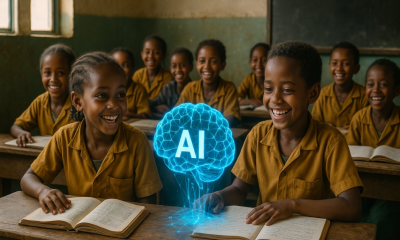Artificial Intelligence
How Teachers Are Adapting to Student Use of AI

As artificial intelligence (AI) tools become increasingly accessible to students, teachers are adjusting their lesson plans, assessment methods and homework strategies to maintain meaningful learning experiences. Rather than viewing AI as a barrier, educators are reshaping their approaches to help students engage critically with content and develop skills that extend beyond what generative tools can provide.
1. Redesigning Assignments With Process, Reflection and Personalization
Teachers are revising assignments to emphasize the learning process instead of only the final product. Many now require students to submit drafts, participate in peer reviews and provide written reflections to demonstrate their thinking at multiple stages. This scaffolding discourages overreliance on AI-generated responses and rewards deeper engagement.
Educators also personalize prompts, asking students to connect tasks to local issues, personal experiences or unique datasets that generic AI models cannot easily replicate. These changes make assignments more authentic and ensure students remain actively involved in their learning.
Some teachers are incorporating interdisciplinary elements into their assignments to strengthen critical thinking further. By blending topics — such as history and current environmental policies or mathematical analysis and art — students must synthesize knowledge from multiple subjects. This approach develops broader problem-solving skills and makes generic AI answers less relevant for completing projects.
2. Altering Assessment Methods and Timing
Assessment practices are shifting toward in-class activities and frequent, low-stakes evaluations. By prioritizing in-class exams and discussions, teachers create opportunities to observe students’ real-time reasoning and comprehension.
Frequent short quizzes, reflections and class discussions provide ongoing feedback, making it easier to identify areas where additional instruction may be needed. Educators are also incorporating alternative formats, such as oral presentations, debates or multimedia projects. These tasks require unique skills that cannot be outsourced entirely to AI.
Some schools are also adopting adaptive digital assessments that adjust question difficulty based on student responses. This approach delivers a more accurate picture of individual understanding while discouraging generic AI use, since students must engage dynamically with evolving tasks.
3. Clarifying AI Policies, Teaching Responsible Use and Building AI Literacy
Clear policies and open conversations about AI use are now common in course syllabi. Teachers specify which AI tools may be used, under what conditions and for which assignments. Beyond rules, educators teach students about AI’s strengths and limitations, helping them understand potential biases, inaccuracies and ethical considerations when using generative systems.
Teachers ensure that responsible AI use becomes part of the learning process by integrating official guidelines and best practices from education authorities. Ethical discussions around fairness, privacy and accountability are encouraged, helping students evaluate AI’s broader societal impacts.
Some educators are incorporating hands-on activities where students critique AI-generated work or compare it to human-created examples. These exercises sharpen critical thinking and make AI literacy a practical skill, rather than just a theoretical discussion. They also prepare students to navigate future academic and professional environments where AI tools will be commonplace.
4. Adjusting Homework Strategies and Out-of-Class Work
Teachers are redesigning homework to include elements AI cannot easily replicate, such as local observations, interviews or fieldwork that tie learning to real-world contexts.
Educators are placing greater emphasis on collaborative work — peer feedback sessions and group projects add accountability and foster critical thinking, making it less likely for students to rely solely on AI. These activities also expose students to different perspectives and problem-solving approaches, preparing them for teamwork beyond the classroom.
Teachers also use homework to strengthen time management and metacognitive skills. By assigning staged deadlines, self-assessment checklists or progress journals, they encourage students to plan ahead, monitor their own understanding and adapt their strategies over time. This focus on reflection and self-regulation equips learners with habits beyond academics, preparing them to navigate complex tasks in the future.
5. Integrating AI as a Learning Aid Rather Than an Adversary
Rather than excluding AI entirely, some teachers encourage students to engage with AI tools under guided conditions. Students may compare AI-generated drafts with their own writing, analyze flaws or biases in AI outputs, and refine the material into stronger work.
Educators also use AI to produce examples or counterexamples for class discussion, turning AI from a potential shortcut into a tool for critical analysis. This approach positions AI as a co-learning partner while maintaining academic rigor.
Teachers sometimes prompt students to fact-check AI outputs against reliable sources, reinforcing research and verification skills. These practices encourage deeper reflection and prepare students to engage thoughtfully with AI in academic and professional settings. They also cultivate a sense of accountability, helping students develop critical thinking and ethical judgment when using emerging technologies.
6. Modifying Lesson Planning and Teaching Methods
Lesson plans are evolving to include real-world, project-based learning opportunities that develop creativity, problem-solving and collaboration skills. Teachers are incorporating multimedia resources like videos, visuals and simulations to diversify instructional formats and reduce reliance on text-based assignments.
By using AI-driven personalization and adaptive content within these updated lessons, educators can better support students with different learning speeds and needs, creating an inclusive environment that sustains students’ interest. The United States recorded a 5.3% dropout rate in 2022, a reminder of the importance of keeping every learner engaged.
Classroom activities now often require students to explain their reasoning live, through discussions or question and answer sessions, so that teachers can observe their analytical processes directly. These interactive exchanges also build students’ confidence in public speaking and help them refine their ability to communicate complex ideas clearly.
7. Expanding Teacher Training, Support and Resource Development
Professional development programs increasingly cover strategies for adapting teaching in an AI-rich environment. These programs train teachers to design fair assessments, evaluate AI-assisted work and stay informed about emerging tools. Schools and districts produce resources like templates, rubrics and grading guides tailored for AI-integrated classrooms.
By fall 2024, 48% of U.S. school districts provided teacher training on AI use — up from just 23% the previous year. This improvement highlights both rapid progress and the continued need for widespread support.
Teachers also collaborate with peers to exchange strategies, observe each other’s classes and share best practices to strengthen their collective ability to adapt. Ongoing mentorship opportunities and peer-led workshops ensure educators remain confident in effectively using evolving technologies. By investing in continuous learning and shared expertise, schools create a supportive culture that successfully empowers teachers to navigate AI-driven changes.
Moving Forward: Strengthening Learning in the Age of AI
The strategies teachers are adopting represent a fundamental shift toward more authentic, process-oriented education. By redesigning assignments, adjusting assessments, clarifying policies and developing their expertise, educators ensure that AI enhances rather than diminishes student learning. These adaptations show that thoughtful integration and continuous reflection can align AI’s capabilities with core educational values.












